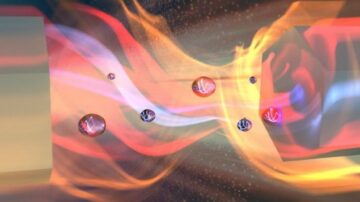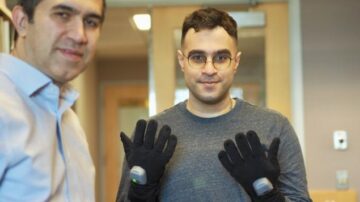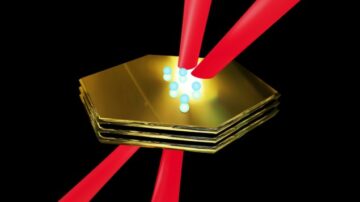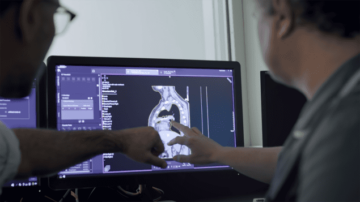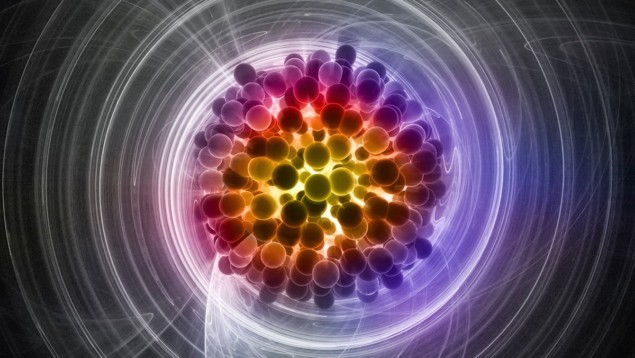
A Compton camera has been used to measure the polarization of gamma rays in a nuclear physics experiment. This was done by a team led by Shintaro Go at Japans’s RIKEN Cluster for Pioneering Research. They say that that their novel approach could help physicists to probe the structure of atomic nuclei in much better detail.
An atomic nuclei contains protons and neutrons that are bound together by the strong force. Much like electrons in an atom or molecule, these protons and neutrons can exist in a number of distinct energy states – often associated with different shapes of the nucleus. Transitions between these states often involve the emission of gamma-ray photons and the study of these photons provides important information about the internal structure of nuclei – a discipline called nuclear spectroscopy.
These studies involve determining both the spin and parity of nuclei, which can be done by measuring the polarization of the emitted gamma rays. However, making accurate measurements of gamma-ray polarization is no easy task.
Multilayer camera
Recently, new opportunities for high-quality measurements have come from a multilayer cadmium–telluride Compton camera design that was first developed by Tadayuki Takahashi and colleagues at the University of Tokyo.
A Compton camera comprises at least two layers of material that interact with, and detect, gamma rays. The process begins with a gamma-ray photon inelastically (Compton) scattering from the first layer. The photon is then absorbed by the second layer. By using position information from the detection of both of these events, the source of the incident gamma ray can be traced back to a circle in space. By measuring many such interactions, the source of a beam of gamma rays can be pinpointed to the intersection of the circles. As a result, Compton cameras have played an important role in gamma-ray astronomy.
Indeed, Takahashi’s design was first developed for use on Japan’s Hitomi mission, which was an ill-fated space telescope that launched in 2016. However, Go points out that “this type of detector has since been applied to a broad range of fields. Its applications range from locating radioactive materials released after the nuclear power plant accident in Japan, to serving as a multi-probe tracker in nuclear medicine.”
Polarization dependent
Now, Go’s team have used Takahashi’s Compton camera in a nuclear spectroscopy experiment that measured the polarization of gamma rays. Their technique takes advantage of the fact that the probability that a photon is Compton scattered at a particular angle is dependent on its polarization. This means that a Compton camera can be used to determine the polarization of a gamma-ray beam originating from a source at a known location.
“This approach provides valuable information about the linear polarization of gamma-rays from excited nuclei,” says Go.

Compton imaging opens up new avenues for diagnostic imaging
In the experiment, the researchers fired a beam of protons at a thin foil of iron. Some of these protons scatter from iron-56 nuclei – putting the nuclei in an excited state that decays by the emission of a gamma-ray photon. In this proof-of-principle experiment, this nuclear transition was chosen because the gamma rays are emitted with a well-known polarization.
To the delight of Go and colleagues, the photon polarization measured by their Compton camera closely matched the known value. Having successfully demonstrated their new experimental technique, Go’s team hope that the camera could soon be applied more widely in state-of-the-art nuclear spectroscopy experiments.
“Our findings include remarkably high sensitivity and efficient detection efficiency,” Go describes. He says that this will be very useful for studying rare radioactive nuclei, which involves detecting very small numbers of photons.
The research is described in Scientific Reports.
- SEO Powered Content & PR Distribution. Get Amplified Today.
- PlatoData.Network Vertical Generative Ai. Empower Yourself. Access Here.
- PlatoAiStream. Web3 Intelligence. Knowledge Amplified. Access Here.
- PlatoESG. Carbon, CleanTech, Energy, Environment, Solar, Waste Management. Access Here.
- PlatoHealth. Biotech and Clinical Trials Intelligence. Access Here.
- Source: https://physicsworld.com/a/compton-camera-measures-gamma-ray-polarization-in-nuclear-physics-experiment/
- :has
- :is
- $UP
- 2016
- 90
- a
- About
- accident
- accurate
- ADvantage
- After
- an
- and
- angle
- applications
- applied
- approach
- ARE
- AS
- associated
- astronomy
- At
- atom
- avenues
- back
- BE
- Beam
- because
- been
- begins
- Better
- between
- both
- bound
- broad
- by
- called
- camera
- cameras
- CAN
- chosen
- Circle
- circles
- closely
- Cluster
- colleagues
- come
- comprises
- contains
- could
- courtesy
- delight
- demonstrated
- dependent
- described
- describes
- Design
- detail
- detect
- detecting
- Detection
- Determine
- determining
- developed
- diagnostic
- different
- discipline
- distinct
- done
- easy
- efficiency
- efficient
- electrons
- emission
- energy
- events
- excited
- exist
- experiment
- experimental
- experiments
- fact
- Fields
- findings
- fired
- First
- foil
- For
- Force
- from
- Gamma rays
- Go
- Have
- having
- he
- help
- High
- high-quality
- hope
- However
- HTML
- HTTPS
- Imaging
- important
- in
- incident
- include
- information
- inner
- interact
- interactions
- internal
- intersection
- involve
- involves
- issue
- ITS
- Japan
- Japan’s
- jpg
- known
- launched
- layer
- layers
- least
- Led
- like
- linear
- locating
- location
- Making
- many
- matched
- material
- materials
- max-width
- means
- measure
- measured
- measurements
- measures
- measuring
- medicine
- Mission
- molecule
- more
- much
- Nature
- neutrons
- New
- no
- novel
- nuclear
- Nuclear medicine
- Nuclear physics
- Nuclear power
- number
- numbers
- of
- often
- on
- opens
- opportunities
- or
- originating
- out
- parity
- particular
- Photons
- Physics
- Physics World
- Pioneering
- plant
- plato
- Plato Data Intelligence
- PlatoData
- played
- points
- position
- power
- probability
- probe
- process
- protons
- provides
- Putting
- range
- RARE
- RAY
- released
- research
- researchers
- result
- RIKEN
- Role
- say
- says
- scattered
- Second
- Sensitivity
- serving
- shapes
- since
- small
- some
- Soon
- Source
- Space
- space telescope
- Spectroscopy
- Spin
- State
- state-of-the-art
- States
- strong
- structure
- studies
- Study
- Studying
- Successfully
- such
- takes
- Task
- team
- technique
- telescope
- that
- The
- The Source
- their
- then
- These
- they
- thin
- this
- thumbnail
- to
- together
- tokyo
- traced
- tracker
- transition
- transitions
- true
- two
- type
- understood
- university
- University of Tokyo
- use
- used
- useful
- using
- Valuable
- Valuable Information
- value
- very
- was
- well-known
- which
- whole
- widely
- will
- with
- workings
- world
- zephyrnet

